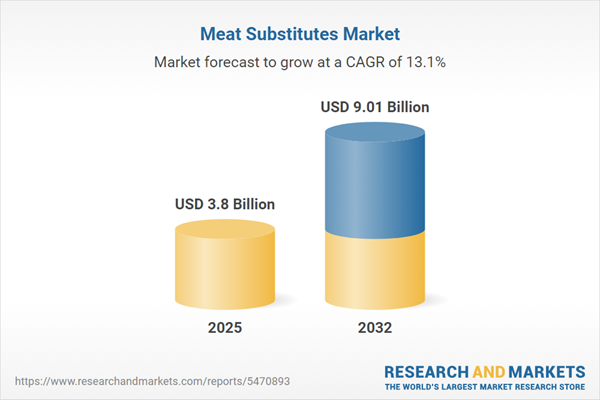Speak directly to the analyst to clarify any post sales queries you may have.
The global meat substitutes market is reshaping as businesses respond to evolving consumer tastes, harness next-generation protein innovations, and adapt supply chains for sustainable, resilient growth. Senior decision-makers are steering their organizations through ongoing change by targeting operational agility and seizing new market opportunities.
Market Snapshot: Growth Drivers and Market Size for the Meat Substitutes Market
The meat substitutes market is advancing rapidly, driven by rising health awareness, sustainability interests, and strong demand for alternative proteins. Companies are intensifying their innovation game, working to launch differentiated products and swiftly expanding their portfolios. As consumer behaviors grow more complicated and regulatory frameworks tighten worldwide, businesses are adopting agile supply chain models. This ongoing transformation enables organizations to create long-term commercial value, maintain competitiveness, and adapt to both emerging consumer sentiment and fluid regulatory standards.
Scope & Segmentation of the Meat Substitutes Market
- Product Types: Burgers, meatballs, mince, nuggets, and sausages remain the pivotal offerings. Firms consistently evolve these to align with dynamic food preferences and the growing appetite for plant-based diets.
- Distribution Channels: Meat substitute products reach a broad consumer base through convenience stores, specialty retailers, online marketplaces, and supermarket hypermarkets. This widespread coverage addresses urban and rural market demands while optimizing last-mile distribution.
- Sources of Protein: Varied protein ingredients—mycoprotein, pea, soy, and wheat—allow custom-tailored foods that address nutritional diversity and allergen considerations, expanding product appeal to different population segments.
- Forms: Ambient, chilled, and frozen variants empower manufacturers to manage shelf life, control distribution logistics, and ensure product freshness across retail systems.
- End-Users: Demand is shaped by restaurants, institutional foodservices, quick-service venues, and households. Each end-user type influences packaging requirements and drives innovation in format and distribution strategies.
- Geographical Regions: The Americas, Europe, Middle East, Africa, and Asia-Pacific each influence product adaptation and regulatory policies. Deep local insights and purposeful localization are vital for regional growth and market compliance.
- Notable Market Players: Companies including Beyond Meat Inc., Impossible Foods Inc., The Kellogg Company, Quorn Foods Limited, Maple Leaf Foods Inc., Unilever PLC, Nestlé S.A., The Hain Celestial Group Inc., The Tofurky Company, and The Meatless Farm Co. Ltd. are elevating market standards through targeted innovation and a global expansion approach.
Key Takeaways for Senior Decision-Makers
- Emerging technologies such as texturized protein ingredients and precision fermentation enhance product quality, supporting standout positioning in an increasingly competitive sector.
- Omni-channel distribution strengthens targeted customer interaction, supporting differentiated assortment strategy and agile category management for shifting consumer behavior.
- Robust supplier relationships and flexible sourcing models ensure operational continuity and support compliance, particularly amid variable global requirements and supply chain disruptions.
- Sustainable business practices—including the integration of regenerative agriculture and conscious ingredient sourcing—align brand reputation with regulatory and customer expectations, strengthening market presence.
- Adapting commercialization strategies to specific regional requirements, particularly in Europe and Asia-Pacific, accelerates compliance, improves market fit, and fosters local consumer engagement.
- Strategic alliances with established players in the broader food sector can speed up the development and market entry of innovative protein offerings, facilitating smoother access to international markets.
Tariff Impact: Navigating Recent U.S. Regulatory Developments
Recent changes in U.S. tariff policy on imported protein ingredients have prompted industry players to deepen their commitment to domestic sourcing and expand local production capacity. Streamlining U.S. supply chains now forms a cornerstone of risk mitigation, reducing exposure to regulatory shifts and enabling rapid market response.
Methodology & Data Sources
This report synthesizes insights from interviews with executive leaders, procurement experts, and specialists in food technology and culinary innovation. Data is then corroborated using company documents, peer-reviewed sources, and in-depth market studies. The methodology ensures the content addresses strategic planning and execution needs for leadership teams.
Why This Report Matters
- Enables executive teams to identify new market opportunities and refine risk management in a complex, evolving sector.
- Provides actionable guidance for regulatory compliance, supply chain adaptation, and .organizational resilience in response to shifting consumer demands.
- Delivers recommendations for advancing protein technologies and shaping partnership or entry strategies for high-impact implementation.
Conclusion
Continuous progress in protein innovation, thoughtful sourcing decisions, and agile regional execution will equip companies to sustain durable growth, adapt to evolving regulations, and capture value in the transforming meat substitutes market.
Additional Product Information:
- Purchase of this report includes 1 year online access with quarterly updates.
- This report can be updated on request. Please contact our Customer Experience team using the Ask a Question widget on our website.
Table of Contents
3. Executive Summary
4. Market Overview
7. Cumulative Impact of Artificial Intelligence 2025
List of Figures
Companies Mentioned
The companies profiled in this Meat Substitutes market report include:- Beyond Meat, Inc.
- Impossible Foods Inc.
- The Kellogg Company
- Quorn Foods Limited
- Maple Leaf Foods Inc.
- Unilever PLC
- Nestlé S.A.
- The Hain Celestial Group, Inc.
- The Tofurky Company
- The Meatless Farm Co. Ltd.
Table Information
| Report Attribute | Details |
|---|---|
| No. of Pages | 181 |
| Published | November 2025 |
| Forecast Period | 2025 - 2032 |
| Estimated Market Value ( USD | $ 3.8 Billion |
| Forecasted Market Value ( USD | $ 9.01 Billion |
| Compound Annual Growth Rate | 13.1% |
| Regions Covered | Global |
| No. of Companies Mentioned | 11 |









